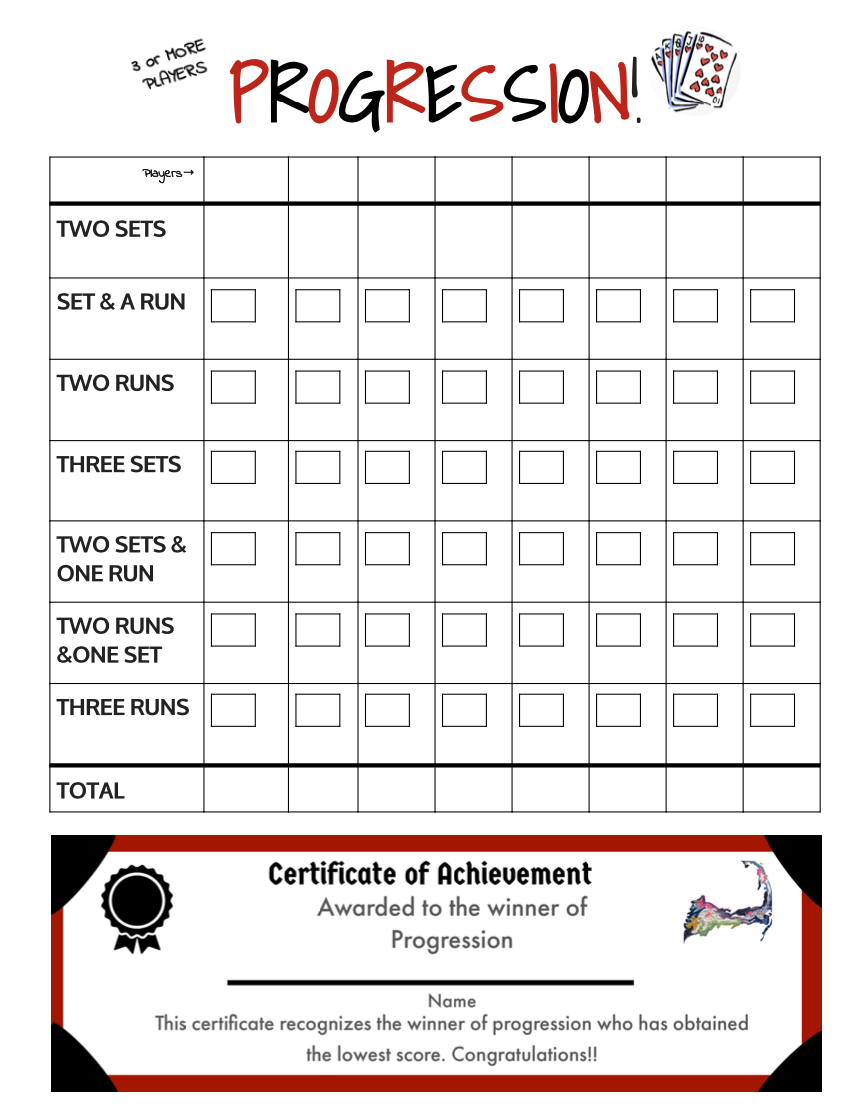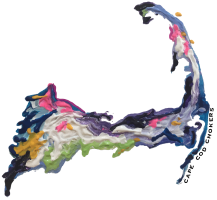
Progression!! The Card Game **FREEBIE**
Share
Our favorite family game we have always called progression. However, it is also known as “May I” or “Continental Rummy”.

The object of the game is to be the player with the fewest penalty points after playing all seven hands. Everyone draws one card, the high card deals, and the subsequent deals are passed to the left.
Two 52-card decks are used plus two Jokers per deck. The number of decks used depends on how many people are playing:
3-5 players use 2 decks
5-6 players use 3 decks
7-8 players use 4 decks
Each player is dealt 11 cards, the remaining stockpile is set on the table. Jokers and TWO’s are wild. After a card is drawn, one must be discarded, and the next player to the left has the option of drawing either the top discard or top stock card then he must discard.
*A set consists of three or more cards of the same face value, e.g., three queens, or three aces, or three sevens.
*A run consists of four or more cards of the same suit, in sequence. If there is an ace in the run, it can serve as either a high card or low card, but not both in the same run.
Seven different deals, or hands, make up one game. Each hand consists of a combination of sets and runs, and there is a different opening requirement for each of the seven hands. The first hand requires a player to open, or "go down," with two sets. A minimum of six cards makes up the first hand's opening requirements, seven cards for the second hand, etc. Each successive hand needs one more card for the opening requirements, until the seventh hand, which requires twelve cards to open. Everyone moves on to the next hand together, regardless of whether they were able to go down during the previous hand.
Once a player has gone down by satisfying the requirements for that particular hand, he may not create any new sets or runs. While playing the first hand of two sets, no player may play three sets. Cards that remain in a player's hand may only be played onto the sets and runs already established on the table.
The sequence of seven hands is as follows:
Two sets
Set and a run
Two runs
Three sets
Two sets 0ne run
Two runs and one set
Three runs
You can see why our family calls it progression. It progressively gets harder.
THE PLAY
Beginning with the player to the left of the dealer, a person's turn begins by selecting either the top card from the stockpile or the top card from the discard pile. If the player does not wish to select from the discard pile, any player in order of rotation to the left of the player may claim that card, but must also draw the top card from the stockpile as a penalty for picking out of turn, without discarding. Conventionally this desire is announced by saying "May I?", thus the alternative name of this game. If several players with the top card, the priority goes to the desiring player closest in rotation to the current player. In such a case:
The order of play is not changed,
The player picking out of turn may not play any cards on the table until his or her next regular turn,
Any remaining cards in the discard pile are ineligible for selection (dead), and
The player whose turn was interrupted resumes play by selecting the top card from the stockpile.
As a point of strategy, it is occasionally advantageous to "May I" for a card not directly useful, in the hopes the penalty card will be useful. (ONLY THREE MAY I’s CAN BE USED PER ROUND).
If the player has not yet opened and has the necessary cards to meet the opening requirements for that hand, he may then lay down the sets and runs appropriate for that hand. Having opened, the player is then free to play (in that same turn and in subsequent turns) additional cards onto existing sets or runs that have already been played on the table. A player may not put any cards into play until he has opened ("gone down").
Wild cards may be used to fill in missing cards in a set or a run, but the wilds can never outnumber the standard cards. Trios of wild cards can be played, however, and only wild cards can be played onto these trios. If a player doesn't verbally declare the value of a joker being played as part of a run, its value is implied by the position in which it is originally placed. Wild cards can be rearranged on a straight to play another card, i.e. Player 1 has a straight of 4–8 of hearts, with a wild standing in for the 5. Player 2 (who is down) can play his 5 of hearts and move the wild card somewhere else.
The end of a turn occurs when a player discards one card onto the discard pile. Play then continues with the next player to the left.
Scoring
Since this is a game winnable based on the fewest points,
5 points for cards from 2–7
10 points for cards 8-K
15 points for Aces
10 points for wild cards (Jokers and Twos).
Great Video to Help. Is not exactly how we play, but close enough. https://www.youtube.com/watch?v=N1-iLzbOcI0&feature=youtu.be
